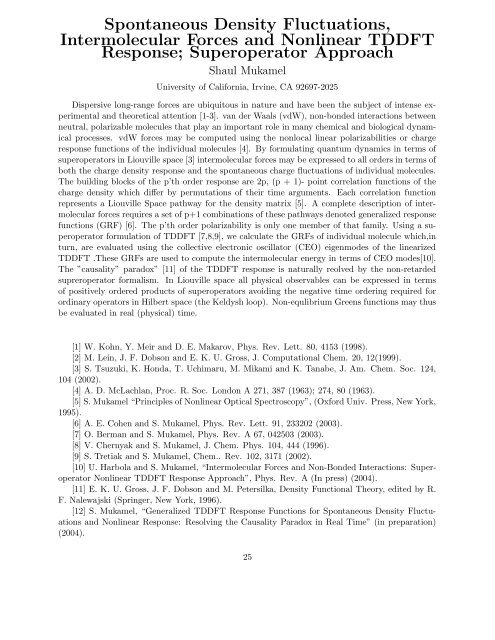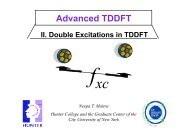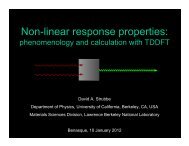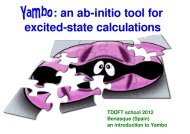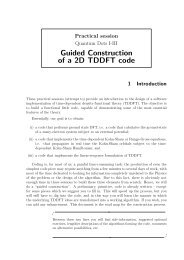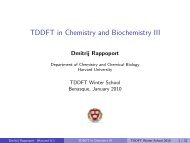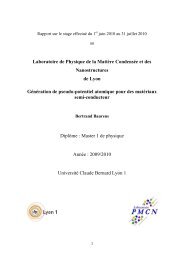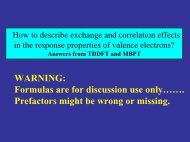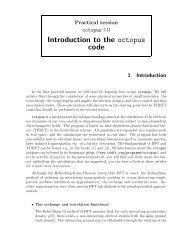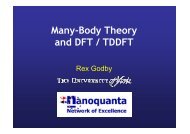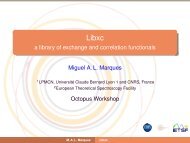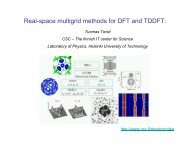TIME DEPENDENT DENSITY FUNCTIONAL THEORY ... - TDDFT.org
TIME DEPENDENT DENSITY FUNCTIONAL THEORY ... - TDDFT.org
TIME DEPENDENT DENSITY FUNCTIONAL THEORY ... - TDDFT.org
- No tags were found...
Create successful ePaper yourself
Turn your PDF publications into a flip-book with our unique Google optimized e-Paper software.
Spontaneous Density Fluctuations,<br />
Intermolecular Forces and Nonlinear <strong>TDDFT</strong><br />
Response; Superoperator Approach<br />
Shaul Mukamel<br />
University of California, Irvine, CA 92697-2025<br />
Dispersive long-range forces are ubiquitous in nature and have been the subject of intense experimental<br />
and theoretical attention [1-3]. van der Waals (vdW), non-bonded interactions between<br />
neutral, polarizable molecules that play an important role in many chemical and biological dynamical<br />
processes. vdW forces may be computed using the nonlocal linear polarizabilities or charge<br />
response functions of the individual molecules [4]. By formulating quantum dynamics in terms of<br />
superoperators in Liouville space [3] intermolecular forces may be expressed to all orders in terms of<br />
both the charge density response and the spontaneous charge fluctuations of individual molecules.<br />
The building blocks of the p’th order response are 2p, (p + 1)- point correlation functions of the<br />
charge density which differ by permutations of their time arguments. Each correlation function<br />
represents a Liouville Space pathway for the density matrix [5]. A complete description of intermolecular<br />
forces requires a set of p+1 combinations of these pathways denoted generalized response<br />
functions (GRF) [6]. The p’th order polarizability is only one member of that family. Using a superoperator<br />
formulation of <strong>TDDFT</strong> [7,8,9], we calculate the GRFs of individual molecule which,in<br />
turn, are evaluated using the collective electronic oscillator (CEO) eigenmodes of the linearized<br />
<strong>TDDFT</strong> .These GRFs are used to compute the intermolecular energy in terms of CEO modes[10].<br />
The ”causality” paradox” [11] of the <strong>TDDFT</strong> response is naturally reolved by the non-retarded<br />
supreroperator formalism. In Liouville space all physical observables can be expressed in terms<br />
of positively ordered products of superoperators avoiding the negative time ordering required for<br />
ordinary operators in Hilbert space (the Keldysh loop). Non-equlibrium Greens functions may thus<br />
be evaluated in real (physical) time.<br />
[1] W. Kohn, Y. Meir and D. E. Makarov, Phys. Rev. Lett. 80, 4153 (1998).<br />
[2] M. Lein, J. F. Dobson and E. K. U. Gross, J. Computational Chem. 20, 12(1999).<br />
[3] S. Tsuzuki, K. Honda, T. Uchimaru, M. Mikami and K. Tanabe, J. Am. Chem. Soc. 124,<br />
104 (2002).<br />
[4] A. D. McLachlan, Proc. R. Soc. London A 271, 387 (1963); 274, 80 (1963).<br />
[5] S. Mukamel “Principles of Nonlinear Optical Spectroscopy”, (Oxford Univ. Press, New York,<br />
1995).<br />
[6] A. E. Cohen and S. Mukamel, Phys. Rev. Lett. 91, 233202 (2003).<br />
[7] O. Berman and S. Mukamel, Phys. Rev. A 67, 042503 (2003).<br />
[8] V. Chernyak and S. Mukamel, J. Chem. Phys. 104, 444 (1996).<br />
[9] S. Tretiak and S. Mukamel, Chem.. Rev. 102, 3171 (2002).<br />
[10] U. Harbola and S. Mukamel, “Intermolecular Forces and Non-Bonded Interactions: Superoperator<br />
Nonlinear <strong>TDDFT</strong> Response Approach”, Phys. Rev. A (In press) (2004).<br />
[11] E. K. U. Gross, J. F. Dobson and M. Petersilka, Density Functional Theory, edited by R.<br />
F. Nalewajski (Springer, New York, 1996).<br />
[12] S. Mukamel, “Generalized <strong>TDDFT</strong> Response Functions for Spontaneous Density Fluctuations<br />
and Nonlinear Response: Resolving the Causality Paradox in Real Time” (in preparation)<br />
(2004).<br />
25


